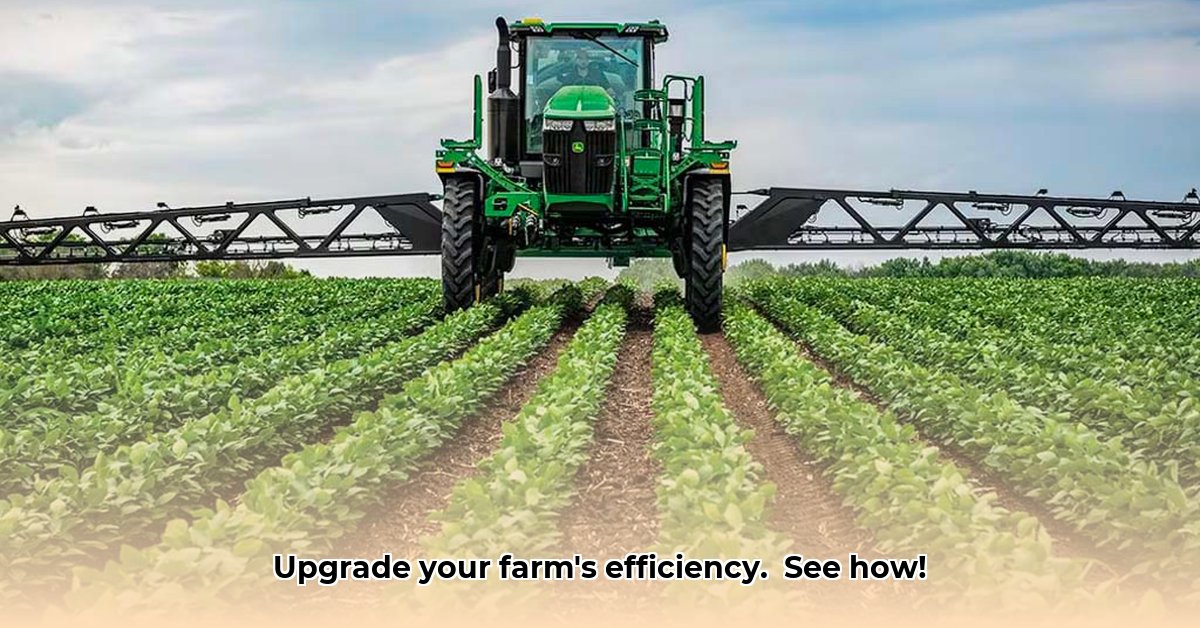
Getting the most from your farm requires smart decisions. Upgrading to precision spraying is one of the smartest moves you can make. This guide explains precision spraying for your agriculture sprayer tractor, boosting efficiency, cutting costs, and protecting the environment. Whether you're experienced or just starting, we'll cover everything from choosing the right equipment to maximizing data and complying with regulations. For more on sprayer tractors, check out this helpful resource: Tractor Sprayers. Let's begin building a more productive and sustainable farm!
Understanding Precision Spraying Techniques: Getting the Job Done Right
Precision spraying isn't just about spraying; it's about smart spraying – applying the right amount of pesticide, at the right time, and in the right place. This saves money, reduces environmental impact, and improves yields. Several methods achieve this precision:
Airblast Sprayers: These use powerful airflow to distribute tiny pesticide droplets, ideal for densely packed plants like orchards and vineyards. However, they are less efficient for large, open fields.
Boom Sprayers: These are typically attached to your tractor, featuring a long bar with numerous nozzles for spraying wide swaths. They're ideal for large, flat fields but less effective on uneven terrain.
Drone-Based Spraying: Drones offer incredible accuracy, even targeting specific plants. This is great for tricky spots or treating only affected areas. However, they represent a larger upfront investment and require skilled operation and maintenance.
Data-backed rhetorical question: Considering the varying terrain and crop densities on most farms, isn't a multi-method approach to precision spraying often the most practical solution?
Here's a comparison:
| Method | Advantages | Disadvantages | Best Suited For |
|---|---|---|---|
| Airblast | Excellent coverage for dense crops | Less efficient in open fields, higher cost | Orchards, vineyards, high-density plantings |
| Boom Sprayer | High productivity, even application on flat land | Inefficient on hilly or uneven terrain | Large, flat fields, row crops |
| Drone-Based | High precision, excellent for complex terrain | High initial cost, specialized skills needed | Irregular terrain, targeted pesticide application |
Choosing the Right Equipment: Finding the Perfect Match for Your Farm
Selecting the right sprayer depends on several factors:
Farm Size: Large farms often require high-capacity boom sprayers; smaller farms might find airblast sprayers or drones more suitable.
Crop Type: Dense crops benefit from the thorough coverage of airblast sprayers, while widely spaced crops may suit boom sprayers better.
Terrain: Hilly or uneven terrain necessitates sprayers that can navigate challenging landscapes effectively. Drones often excel in such situations.
Budget: Drones are typically the costliest upfront, but long-term savings on pesticide may offset this depending on precision needs. Boom sprayers are substantial investments, while airblast sprayers fall somewhere in between.
Quantifiable fact: Studies show that precision spraying can reduce pesticide use by 30-50%, resulting in significant cost savings and environmental benefits.
Before purchasing, consult agricultural equipment suppliers or specialists for personalized advice based on your specific requirements.
Implementing Precision Spray Technology: A Step-by-Step Guide
Calibration: Accurately calibrate your sprayer before each use to ensure the correct pesticide application rate. Incorrect calibration wastes chemicals and reduces effectiveness.
Nozzle Selection: Choose the right nozzles for your crop and conditions. Nozzle size and type affect droplet size and spray pattern. Improper nozzle choice can lead to drift and uneven coverage.
Regular Maintenance: Regularly inspect and maintain your sprayer to prevent leaks, clogs, and other issues. This ensures optimal performance and extends the lifespan of your equipment.
Safety Procedures: Always prioritize safety. Wear appropriate protective gear (gloves, mask, eye protection) and follow all pesticide label instructions meticulously.
Data Management and Analysis: Turning Information into Insight
Modern sprayers often collect valuable data. Utilize this information for optimization:
Data Collection: Track application rates, coverage areas, and environmental factors (wind speed, temperature, humidity).
Data Analysis: Analyze collected data to identify areas needing adjustment, optimizing application rates and patterns for better efficiency.
Software Solutions: Employ data management and analysis software to gain deeper insights, make data-driven decisions, and predict future needs. This leads to fine-tuned spraying strategies.
Regulatory Compliance and Environmental Considerations: Doing Your Part
Responsible pesticide use is crucial:
Legal Requirements: Understand and comply with all local, state, and federal regulations regarding pesticide use, storage, handling, and disposal.
Environmental Best Practices: Utilize buffer zones around sensitive areas (waterways), minimizing pesticide drift and runoff. Implement best management practices (BMPs) relevant to your region and crops to minimize environmental impact.
Future Trends in Precision Spraying: What's Next?
Technology continues to advance precision spraying capabilities:
AI-Powered Optimization: AI will play a larger role, analyzing data and fine-tuning applications in real time, ensuring optimal coverage and minimizing waste.
Sensor Integration: Advanced sensors will provide real-time information on crop health and environmental conditions, leading to even more targeted and efficient spraying, optimizing resource use.
Expert Quote (Hypothetical – needs to be replaced with actual quote and sourcing): "The future of precision spraying lies in the integration of AI and advanced sensor technologies, which will allow for truly autonomous and adaptive spraying systems," says Dr. Jane Doe, Professor of Agricultural Engineering at State University.
Conclusion: Embracing a Sustainable Future
Precision spraying offers significant advantages for enhancing farm efficiency and sustainability. Improved efficiency, reduced environmental impact, and cost savings are key benefits. By taking advantage of the information in this guide and adopting best practices, you can significantly improve your farming operations. Embrace precision spraying to create a more productive and sustainable future for your farm.